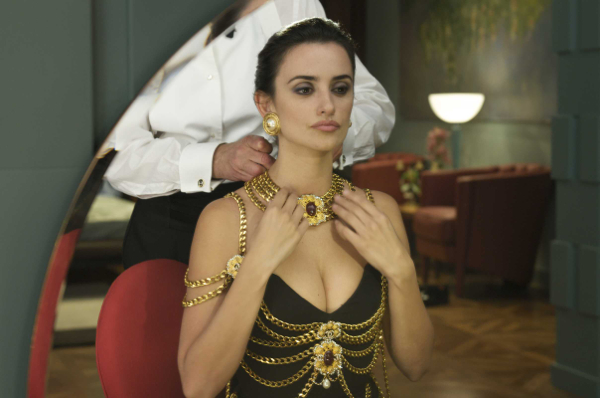Movie review by Greg Carlson
Spanish maestro Pedro Almodovar should easily win new converts to his cult of admirers with the ravishing “Broken Embraces,” a liquid bonbon of metafiction bearing many of the filmmaker’s hallmarks, including a superb performance by occasional muse Penelope Cruz. With few exceptions, most notably Woody Allen’s “Vicky Cristina Barcelona,” Cruz is at the peak of her game when working for Almodovar, and “Broken Embraces” is a dream vehicle for the performer, who plays a call girl/secretary/movie actress in a fantasy wonderland of humor and drama that belongs unmistakably to the imagination of its creator.
Heavy with the melodramatic flourishes that have transformed the filmmaker’s name into an adjective, “Broken Embraces” combines the guilty pleasures of soap opera romance with the director’s longstanding veneration of Alfred Hitchcock and classic film noir. Told mainly from the point of view of blind filmmaker Mateo Blanco/Harry Caine (Lluis Homar), “Broken Embraces” jumps between its contemporary setting and a series of events that transpired some fourteen years earlier. During the course of the story the audience will discover how the director lost his eyesight as well as the reason for his dual monikers.
Chief factor in the mystery is Lena (Cruz), the devastatingly beautiful wannabe actress who falls for Mateo during the production of his movie “Girls and Suitcases,” the film-within-the-film that allows Almodovar to quote purposefully from his own “Women on the Verge of a Nervous Breakdown.” Lena’s much older lover Ernesto (Jose Luis Gomez) is bankrolling Mateo’s project and enlists his creepy son Ernesto Jr. (Ruben Ochandiano) to make a “behind the scenes” documentary as a means of spying on Lena. Ernesto also retains a lip reader to translate the inaudible exchanges captured by his son’s camera, and one haunting image in “Broken Embraces” focuses on Ernesto’s stricken face as he jealously watches footage of Lena and Mateo while seated next to the unblinking glow of the red, green, and blue eyes of his video projector.
Many of the best scenes in “Broken Embraces” reflect on the act of looking and the desire to comprehend the meanings conveyed by visual narrative. Hitchcock and voyeurism were a match made in movie heaven, but Almodovar is just as deliberate as the Master of Suspense in exploring the ways that watchers find and take pleasure – and along with it – some amount of pain. Almodovar’s exquisitely designed productions, which pop with solid blocks of saturated rainbow hues, especially red, explode with mouthwatering compositions that complement the considerable amount of dialogue spoken by the ensemble.
In addition to Hitchcock, Almodovar pays tribute to numerous cinematic inspirations, including Orson Welles, Douglas Sirk, Michael Powell, Louis Malle, and Roberto Rossellini, inviting fellow movie lovers to notice the references and quotations. One need not be familiar with specific motion pictures to enjoy the strange, emotionally complex journeys concocted by Almodovar, but earnest cinephiles will appreciate the shower of intertextuality. “Broken Embraces” is by no means Almodovar’s best film, even though it does happen to be his most expensive and longest. Instead, it is both thematically representative of the filmmaker’s impressive body of work and introspective in a manner that is most welcome.
